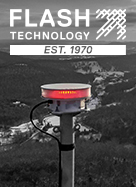
The National Weather Service has identified a microburst as the cause of the collapse of KTXS’s tower in Abilene, TX. Although there were peak winds of 90 mph, it is unknown what the tower was designed for in 1967 when it was erected under the second year of the publication of the EIA RS-222A standard. (Photo: KTXS-TV)
The National Weather Service (NWS) has confirmed that the dramatic collapse of KTXS-TV’s 199-foot broadcast tower during storms on June 8 in Abilene, TX, was caused by a microburst, not a tornado, putting to rest speculation surrounding the severe weather event.
According to the official NWS damage survey released Wednesday, the microburst struck northern Abilene at approximately 11:09 p.m. on June 8, delivering peak winds of 90 mph along a 4-mile path. The tower, erected in 1967, was bent and thrown across the station’s property. Its base remained intact.
In addition to the tower collapse, a rooftop air conditioning unit was torn loose and contributed to a roof cave-in and partial brick wall failure at the rear of the building’s garage. The carport’s roof was also blown off, with one panel landing on the far side of the structure.
The NWS survey cited other damage across northern Abilene, including uprooted trees, damaged signage, a destroyed drive-in theater screen, and a partially collapsed brick wall at the Hardin-Simmons University football field.
While initially believed to be straight-line winds, the localized nature and intensity of the damage led the NWS to identify a microburst—a violent downward wind burst associated with thunderstorms—as the cause.
No injuries or fatalities were reported. The NWS noted the findings are preliminary pending final review.
According to the NWS, a microburst is a “convective downdraft with an affected outflow area of less than 2-½ miles wide and peak winds lasting less than 5 minutes. Microbursts may induce dangerous horizontal/vertical wind shears.”















